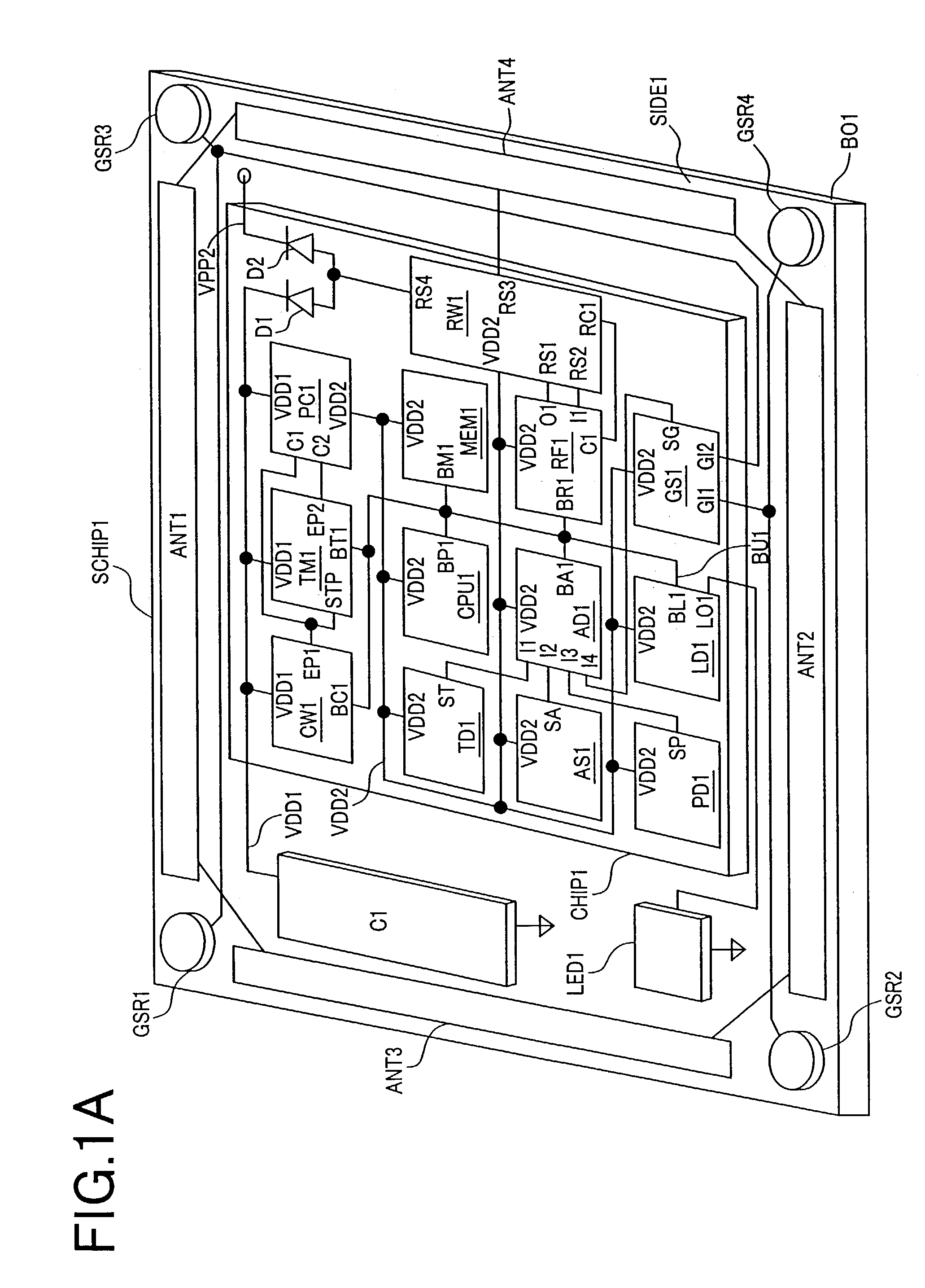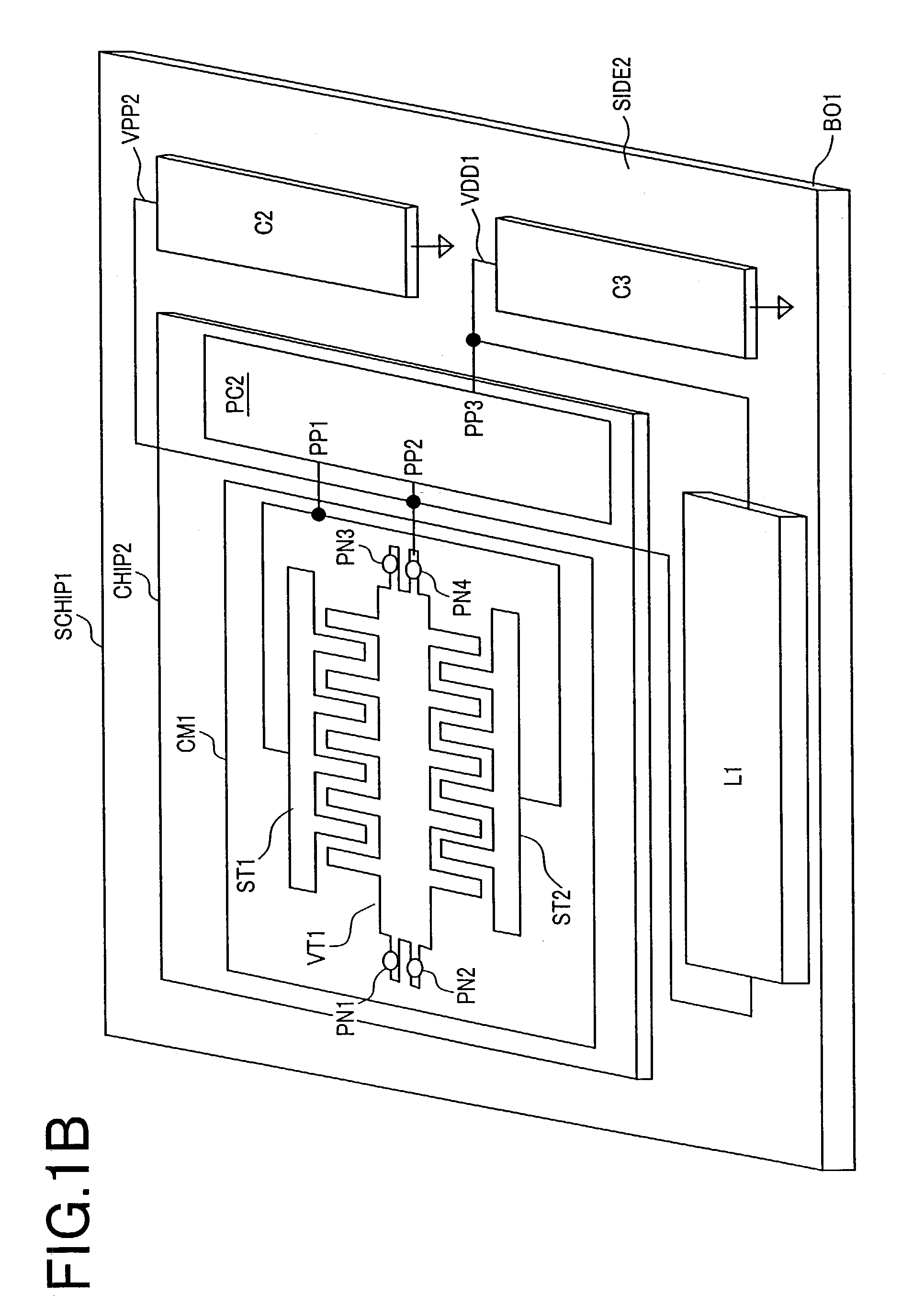Semiconductor device for sensor system
- Summary
- Abstract
- Description
- Claims
- Application Information
AI Technical Summary
Benefits of technology
Problems solved by technology
Method used
Image
Examples
first embodiment
[0067]FIGS. 1A and 1B are block diagrams of a semiconductor device for a sensor system, that is, a sensor chip. FIG. 1A shows one main side (SIDE1) of the sensor chip, while FIG. 1B shows the other main side (SIDE2), that is the back side thereof. The sensor chip (SCHIP1) comprises a first semiconductor integrated circuit (CHIP1), a second semiconductor integrated circuit (CHIP2), a light emission diode (LED) chip (LED1), capacitors (C1 to C3), an inductor (L1), and a substrate (BO1) for mounting those chips and parts. The substrate (BO1) has wiring patterns for the connection among those chips, antenna patterns (ANT1 to 4) for use by a high frequency transmission / reception circuit (to be described later), and electrode patterns (GSR1 to 4) for use by a sensor circuit (GS1) (to be described later). Those patterns are formed with such metal materials as copper, gold, or the like. The chips and patterns are similar to those used usually for MCP (Multi Chip Package) chips.
[0068]FIGS. 2...
second embodiment
[0120]In the first embodiment, the MCP configuration is employed for the sensor chip of the present invention. On the other hand, the MEMS process is compatible with the semiconductor process, so that the MEMS variable capacitor can be integrated with other circuits, such as the sensors, the microprocessor, etc. on one chip. FIG. 22 shows a sensor chip in which the MEMS variable capacitor is integrated together with such other circuits as sensors, a microprocessor, etc. The sensor chip can also be reduced in size even in such a configuration. However, the MEMS variable capacitor is required to have a comparatively large area. If the sensor chip has a configuration as shown in FIG. 22 and a large MEMS variable capacitor is used, therefore, it is difficult to reduce the sensor chip in size.
[0121]FIG. 23A through FIG. 23C show a favorable configuration of such a sensor chip to reduce its size. In FIGS. 23A through 23C, the configurations of the PC1, PC2, and CPU1 circuits are the same ...
third embodiment
[0124]In the first embodiment, the MCP configuration specific to the sensor chip of the present invention is employed to integrate a small power generator that uses a MEMS variable capacitor, sensors, a microprocessor, a memory, a high frequency circuit, a power supply control circuit, etc. in a sensor chip to realize a compact and light-weight health care instrument. On the other hand, there is also a power generator or battery that can supply an electric power of 0.1 mW or so in a size roughly equal to that described above.
[0125]For example, FIGS. 24A and 24B show an example of a sensor chip that uses a power generator that makes good use of electromagnetic induction. FIG. 24A shows a side cross-sectional view of the chip and FIG. 24B shows a planar cross-sectional view of the chip. This power generator has the same configuration as that disclosed in the above-referenced document 11. A cavity CA1 is formed on the SIDE2 of the substrate BO2. A permanent magnet MA1 and a supporting ...
PUM
 Login to View More
Login to View More Abstract
Description
Claims
Application Information
 Login to View More
Login to View More - R&D
- Intellectual Property
- Life Sciences
- Materials
- Tech Scout
- Unparalleled Data Quality
- Higher Quality Content
- 60% Fewer Hallucinations
Browse by: Latest US Patents, China's latest patents, Technical Efficacy Thesaurus, Application Domain, Technology Topic, Popular Technical Reports.
© 2025 PatSnap. All rights reserved.Legal|Privacy policy|Modern Slavery Act Transparency Statement|Sitemap|About US| Contact US: help@patsnap.com



